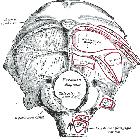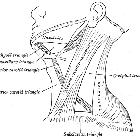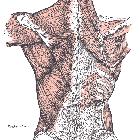trapezius muscle

A
cross-section diagram of the human neck at the level of C6 showing the fascia compartments, muscles, organs, bone, and major arteries, veins, and nerves.





The trapezius muscle is a large, broad superficial muscle of the posterior neck and back. It gains its name from its diamond shape. Along with sternocleidomastoid muscle, it is invested by the superficial layer of the deep cervical fascia, which splits around it.
Summary
- origin: superior nuchal line, inion, nuchal ligament, and spinous processes of C7-T12 vertebrae
- insertion: clavicle and scapula
- innervation: accessory nerve (CN XI)
- action: complex movements of the scapula and neck
Gross anatomy
Origin
It has many origins due to its large size:
- medial third of superior nuchal line
- inion and external occipital protuberance
- nuchal ligament
- spinous processes of C7-T12 vertebrae and the corresponding supraspinous ligaments
Insertion
- clavicle: lateral third
- scapula: acromion and spine
Relations
- it lies superficial (posterior) to multiple muscles (from superior to inferior):
- semispinalis capitis
- splenius
- levator scapulae
- rhomboid minor
- rhomboid major
- latissimus dorsi and thoracodorsal fascia
Innervation
- spinal part (C2, C3) of the accessory nerve (cranial nerve XI) provides motor supply
- C3 and C4 spinal nerves supply pain and proprioceptive fibers
Action
- all fibers: retract the scapula medially
- upper fibers only: elevate and rotate scapula up to aid in shoulder abduction
- middle fibers only: retract scapula
- lower fibers only: depress and rotate scapula down
- upper and lower fibers together: rotate spinous process of scapula superiorly
- with the shoulders fixed:
- bilateral contraction extends neck
- unilateral contraction produces ipsilateral flexion
Siehe auch:
und weiter:

 Assoziationen und Differentialdiagnosen zu Musculus trapezius:
Assoziationen und Differentialdiagnosen zu Musculus trapezius:
